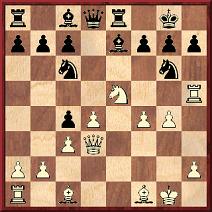
When contacting us by e-mail, correspondents are asked to include their name and full postal address and, when providing information, to quote exact book and magazine sources. The word ‘chess’ needs to appear in the subject-line or in the message itself.
| First column | << previous | Archives [11] | next >> | Current column |
A number of C.N. items (see pages 214-219 of Kings, Commoners and Knaves, as well as C.N.s 3096 and 3115) have discussed positions in which a player moved his queen to KKt6 (i.e. g6 or g3) when the opponent had three unmoved pawns before his castled king. Below is a complete list of the instances which we have found and cited previously:
The present item reverts to the two Fox games, the first of which is well known: 1 e4 e5 2 Nf3 Nc6 3 Bb5 Nf6 4 O-O Nxe4 5 Re1 Nd6 6 Nxe5 Be7 7 Bf1 O-O 8 d4 Nf5 9 c3 d5 10 Qd3 Re8 11 f4 Nd6 12 Re3 Na5 13 Nd2 Nf5 14 Rh3 Nh4 15 g4 Ng6 16 Rh5 Nc6 17 Ndc4 dxc4

18 Qxg6 hxg6 19 Nxg6 fxg6 20 Bxc4+ Black resigns.
Regarding the complications arising from this game, stated to be ‘M.A. Fox v H.E. Bauer, Antwerp, 1901’, we wrote in C.N. 1994:
‘The players’ names and the occasion are taken from page 145 of the May 1901 Deutsche Schachzeitung, but subsequent publications added numerous changes. The Basis of Combination in Chess by J. du Mont claimed (see pages 135 and 215) that White was A.W. Fox. So did page 133 of The Golden Treasury of Chess “compiled by the editors of Chess Review” (London, 1958), a book which, moreover, stated “Washington, D.C., 1901”. Page 48 of 500 Ruy Lopez Miniatures by Bill Wall followed the Treasury version but gave “J. Bauer” as Black. Page 46 of All About Chess by Al Horowitz proposed “A.W. Fox v J.H. Bauer”, although the latter, who lost a famous game to Lasker, had died in 1891.Chess literature contains a further game with a spectacular Qg6, and, coincidentally, it too involves a Fox. The following position may be found on page 52 of Combinations The Heart of Chess by Irving Chernev:
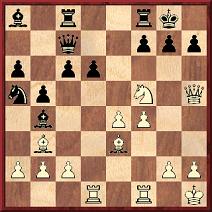
This is given as Fox v Casper, but no venue or date is stipulated. The finish was 1 Bb6 Qxb6 2 Qg6 hxg6 3 Ne7+ Kh7 4 Rf3 Qc5 5 Rd5 Black resigns, although Chernev notes a simpler win: 1 Qg5 g6 2 Qh6 gxf5 3 Bd4, etc. See also page 3 of Blunders and Brilliancies by Ian Mullen and Moe Moss.’
That two such Qg6 games should be won by a player named Fox may seem curious to the point of fishiness, but there are even more complications, and an even greater apparent coincidence, to consider.
The above Fox v Bauer game was, we now note, published on pages 145-146 of the July 1901 American Chess World, with the headings ‘A.W. Fox – H. Bauer’ and ‘Played at Antwerp on 11 December 1900’. The score continued with 20...Kf8 21 Rh8 mate. Moreover, page 36 of the February 1901 issue had given the other Fox game in full (identifying Black as Karper, whereas Chernev had put Casper, and giving no details about the occasion):
1 e4 e5 2 Nf3 Nc6 3 Bc4 Bc5 4 d3 a6 5 Nc3 Bb4 6 O-O Nf6 7 Be3 b5 8 Bb3 Bb7 9 Nd5 Nxd5 10 Bxd5 d6 11 d4 Qe7 12 Kh1 Na5 13 Qe2 c6 14 Bb3 exd4 15 Nxd4 O-O 16 Nf5 Qd7 17 Rad1 Qc7 18 f4 Rac8 19 Qh5 Ba8 (This is the position in which Chernev’s book took up the game, as in the diagram above.) 20 Bb6 Qxb6 21 Qg6 hxg6 22 Ne7+ Kh7 23 Rf3 Qc5
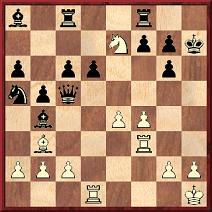
24 Rd5 Resigns.
In that February 1901 issue of the American Chess World no initials for Fox were indicated in the above game’s heading, but immediately before it came a game-score headed ‘J.W. Fox – F.B. Walker’ (1 e4 e5 2 Nf3 Nc6 3 Bb5 Nf6 4 O-O Nxe4 5 d4 Be7 6 Qe2 Nd6 7 Bxc6 bxc6 8 dxe5 Nb7 9 Nc3 O-O 10 Re1 Re8 11 Qc4 Nc5 12 Ng5 Bxg5 13 Bxg5 Qxg5 14 Qxc5 Bb7 15 Rad1 d5 16 Qb4 Bc8 17 Re3 Rxe5 18 Nxd5 Rxe3 19 Ne7+ Resigns). And, just before that, there was this introduction to the pair of games:
‘Through the medium of the Washington Star we learn of a Mr J.W. Fox, of whom it may be said – he will awake some morning to find himself famous. In the two examples given below, he is seen to be conversant with the latest developments in opening play, and quick to perceive the vulnerable point in his adversary’s position. Mr Fox has been abroad for several years, pursuing his studies, and is expected to take up a permanent residence in Washington this year.’
No mention was made of where either ‘J.W. Fox’ game was played, and we wonder if a reader in the US has access to the Washington Star, to ascertain whether further details were provided there.
Later in 1901, the American Chess World (July issue, page 146) attributed a further brilliancy to A.W. Fox (over A. Clerc at the Café de la Régence, again without any date given): 1 e4 e5 2 Nf3 Nc6 3 Bb5 Nf6 4 O-O Nxe4 5 d4 Be7 6 Qe2 Nd6 7 Bxc6 bxc6 8 dxe5 Nb7 9 Nc3 O-O 10 Be3 Nc5 11 Bxc5 Bxc5 12 Ne4 Be7 13 Rad1 a5 14 Rfe1 a4 15 Nd4 Qe8 16 Qh5 Kh8 17 Nf6 Bxf6 18 exf6 Qd8 19 fxg7+ Kxg7 20 Nf5+ Kh8 21 Qh6 Rg8
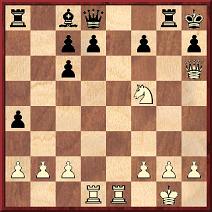
22 Re8 Resigns. ‘Trip-hammer brilliancy of the highest order’, commented the magazine.
The September 1901 issue (page 162) quoted from the New Orleans Times-Democrat ‘the following pretty ending which occurred in a game played at Anvers [i.e. Antwerp in French] in December 1900, between Messrs Segal and A. Fox’:
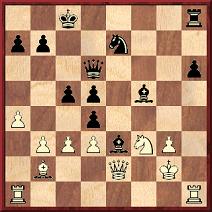
23...Qxg3+ 24 Kxg3 Rg8+ 25 Kh4 Ng6+ 26 Kh5. ‘Black mates in three.’
By now, the many Fox combinations were provoking comment, and on pages 152-153 of the September 1901 American Chess World the following paragraphs were cited from the Pittsburg Dispatch under the title ‘Mr Fox not a Myth’:
‘The excellence of a number of brilliant games published in this and other chess periodicals, played by A.W. Fox, of Washington, has aroused a suspicion in the minds of not a few chessplayers that Mr Fox might have been, after all, the imaginative product of him who had given most of these games to the public. Our Game Editor disposes of the idea that he has been guilty of palming off a “gold brick” upon the chess reading public, thusly:
“Some lively speculation has been indulged of late as to the authorship of those remarkable games attributed to a Mr Fox. Of itself the rumor that they are spurious is not wanting in virtue, for it shows us there are still those who believe their eyes. They pounce upon these delicacies as contraband having run the blockade of their most exalted notions. To be told, without any gilding of the pill, that you are the suspected author of certain charming conceits is, to put it mildly, an equivocal compliment. This is the writer’s position, however, and as he relishes a good joke, the intimations are forgiven. Information concerning Mr Fox can be had by inquiry at the Washington, DC Chess Club. When we take to depositing unicorn eggs on the chess fraternity, the scribes may expect a product not less amiable than estimable.”’
So what sense can be made of the Fox jumble? We have seen above that the American Chess World a) ascribed to both J.W. Fox and A.W. Fox brilliant miniatures against the same 8...Nb7 line in the Ruy López, b) stated that J.W. Fox ‘has been abroad for several years’, and c) quoted games played by A.W. Fox in Belgium and France. If A.W. Fox was, as might be supposed, the relatively well-known player Albert Whiting Fox (1881-1964), his age would indeed be that of a student, and the logical conclusion from the foregoing is, of course, that the two references in the February 1901 to ‘J.W. Fox’ were simply mistakes for A.W. Fox.
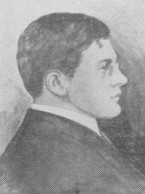
Albert Whiting Fox
It may be added here that in 1901 the American Chess World gave only one loss by A.W. Fox, on pages 225-226 of the December issue: 1 e4 c5 2 Nf3 Nc6 3 d4 cxd4 4 Nxd4 g6 5 Be3 Bg7 6 Bc4 Nf6 7 Nc3 d6 8 O-O O-O 9 f4 Bd7 10 h3 Rc8 11 Bb3 Qa5 12 Qf3 Ne8 13 Rad1 a6 14 g4 e6 15 Qg3 Kh8 16 Nf3 Qd8 17 f5 gxf5 18 exf5 Na5 19 fxe6 fxe6 20 Ng5 Qe7 21 Rxf8+ Bxf8 22 Rf1 Nf6 23 Qh4 h6 24 Nf7+ Qxf7 25 Rxf6 Qh7 26 Bxe6 Bxe6 27 Rxe6 Nc4 28 Bxh6 Ne5 29 Qf6+ Kg8 30 Nd5 Qxh6 31 Ne7+ Kh7 32 Qxh6+ Bxh6 33 Nxc8 and wins. No occasion was indicated, but White was named as F.B. Walker (who, it will be recalled, the magazine said earlier in the year had lost a game to ‘J.W. Fox’).
But were all the Fox games, and particularly the spectacular queen sacrifices, genuine? Most notably, in the game between Fox and Karper/Casper is suspicion justified over the way Black’s slow moves 18...Rac8 and 19...Ba8 allowed the final combination to be set up? For that game, moreover, what was Chernev’s source for naming Black as Casper, rather than Karper? And where and when was it played?
Pages 187-189 of Napier The Forgotten Chessmaster by John S. Hilbert (Yorklyn, 1997) contain some relevant information on A.W. Fox. It is reported, for instance, that Napier gave the Fox v Karper game (the occasion being specified as ‘Heidelberg, 1901’) in his column in the Pittsburg Dispatch of 28 January 1901, misidentifying White as J.W. Fox (who, Dr Hilbert added, was Albert Fox’s father). The Napier book also gave the complete score (1 e4 d5 2 e5 Bf5 3 d3 e6 4 h4 h6 5 Be2 c5 6 b3 Nc6 7 Bb2 d4 8 f4 Be7 9 g3 Nb4 10 Na3 Qa5 11 Kf2 Nd5 12 Nc4 Qc7 13 Bf3 f6 14 Qe2 O-O-O 15 a4 g5 16 hxg5 fxg5 17 fxg5 Bxg5 18 Bxd5 exd5 19 Nd6+ Rxd6 20 exd6 Be3+ 21 Kg2 Qxd6 22 Nf3 Ne7 23 c3 Qxg3+ 24 Kxg3 Rg8+ 25 Kh4 Ng6+ 26 Kh5 Nf4+ 27 Kxh6 Ne6+ 28 Qxe3 Rh8 mate.) of the above-mentioned game wherein Fox, as Black, played a different kind of queen sacrifice on g3. The book named Black as Segel, not Segal, and described it as an offhand game dated 1901. This was on the basis of Napier’s column of 15 July 1901, which had stated:
‘... we are enabled to present another specimen of the play of A.W. Fox, the young American so recently sprung into fame and the liberal praise of critics. Dr Lasker, when in Pittsburg, admitted that if Mr Fox were not a myth living in someone’s mind he certainly gave evidence of a brilliant career.’
Dr Hilbert’s book (page 189) also included the passage, quoted above, which began ‘Some lively speculation ...’, pointing out that it had appeared in Napier’s Dispatch column of 12 August 1901. Thereafter Dr Hilbert gave the Fox v Bauer encounter (‘Washington, 1901’).
Thus we still have a contradiction over the venue of the Fox v Bauer game (Washington or Antwerp?) and the date (1900 or 1901?), but an easier matter to settle is the reference in the May 1901 Deutsche Schachzeitung to ‘M.A. Fox’. An earlier publication of the game, we now note, was on pages 79-80 of the 15 March 1901 issue of La Stratégie, which presented it as an ‘Intéressante partie jouée récemment à Anvers’, headed ‘M. A. Fox – M. H.-E. Bauer’ and with notes ascribed to ‘M. A. Fox’. M. A. Fox clearly meant Monsieur A. Fox.
But were the two games featuring that rarest of queen sacrifices on g6 really played not only by the same person, A.W. Fox, but also within a few months of each other? Were they really played at all? Or are there good grounds for regarding either of them as an invention or hoax?
Marking the tenth anniversary of the publication by B.T. Batsford Ltd. of an algebraic edition of Fischer’s book My 60 Memorable Games, we make available here Fischer’s Fury, an account of the scandal.

This illustration appears on page 22 of Famous Chess Players by Peter Morris Lerner (Minneapolis, 1973):
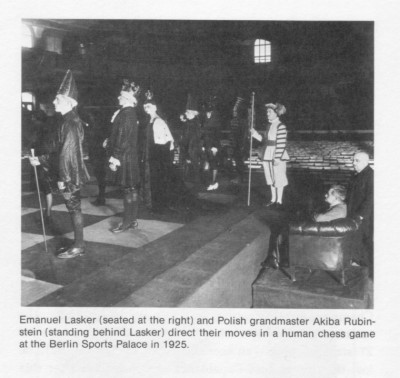
The date 1925 is an error for 1924, but we also suggest that the person on the far right is not Akiba Rubinstein but, probably, Ossip Bernstein. The latter participated in the event, as reported on page 300 of the October 1924 Wiener Schachzeitung.
C.N. 3772 asked for the meaning of these exchanges during a game:
White: ‘Helm knight.’
Black: ‘Kraal.’
White: ‘Munster.’
Black: ‘Minstrel.’
Umpire: ‘Machine.’
The answer is that the terms were designed for use during telegraphic games, as explained on pages 67-72 of The British Chess Code (London, 1903). Below is a translation:
White: ‘Your record is illegal. I exact Penalty A and Penalty C, but as your king cannot move, you must move your knight.’
Black: ‘The move you require me to make by way of penalty is illegal, and I must disregard your requirement. You have forfeited your right to exact a penalty for this offence.’
White: ‘As you refuse to abide by the Laws of the Game, you have forfeited the game.’
Black: ‘I claim the game, as you refuse to comply with my legal requirement. After knowledge of your refusal, I have despatched no record of a subsequent move of my own.’
Umpire: ‘Your opponent, having referred for the conduct of the game to something printed or written that treats of chess, forfeits the game.’
Paul Valois (Leeds, England) sends us the chess section of The Tablet, 8 November 1919 (page 612), in which the columnist, Father Eugene O’Sullivan, reported on a discussion with Capablanca. We quote the item in full:
‘Philidor, as I stated last week, began to play chess at the age of six [sic]. Capablanca, the present hero of the chess world, began to play and to win games at the age of four. I had the information from his own lips on Wednesday, when I sat by his side for an hour at a banquet given in his honour. There are one or two other items of interest which I proceed to relate. In the course of conversation I produced a copy of The Tablet article on “The King of Games” and asked him to glance through it. He kindly did so and with evident interest. I thereupon asked him whether I might not have the honour of conveying some little message from him to The Tablet. “Yes, certainly”, he replied; “you can say that I agree with the article generally, and very much so with what it says about the beneficial influence of chess upon the mind and general character. Chess is no idle pastime. It is a mind-trainer, a great educator, and as a Catholic myself I am greatly pleased to see the leading Catholic organ of the English-speaking world devoting serious attention to the claims of chess.” I then trespassed further on his kindness and asked him whether he could say a word that might help those readers of The Tablet who were taking an interest in chess but were as yet only beginners or players of moderate strength. “Could you, Señor, recommend to them any particular course of procedure, or any particular books?” “Books!”, he replied; “no. Any handbook will help in the elementary stages, but one can no more acquire proficiency in chess by means of books alone than he can proficiency in music or painting, or any other art or science, by means of books alone. I am bringing out a three-volume treatise myself on ‘The Fundamentals of Chess’. Of course I think it will be a good and helpful book, but – nemo judex in sua causa. No book, however good, can supply the place of the living teacher. Whoever desires to make satisfactory progress should take lessons from one who is skilled in the game, and the more skilled the teacher the more rapid and satisfactory will the progress be.”
“In a general way, Señor, is there any warning or exhortation which you would give to a player of moderate skill who is desirous of strengthening his play?” “Yes. There are two very common faults to be warned against – one that of the player who is too passive, the other that of the player who is too enterprising. Tell your young Tablet friends to avoid a too passive style as the Devil avoids holy water. The Devil is to be pitied in an atmosphere of holy water; so is a chessplayer in an atmosphere of passivity. No progress is possible for a player with such a style of play. The warning against being too enterprising is for skilled players. Until a fair degree of skill is attained one can hardly be too enterprising, but one can easily be so afterwards, and very often is so. To beginners and players of moderate strength I would say: ‘Don’t be too passive in your play; be enterprising.’ To skilled players I would say: ‘Don’t be too enterprising.’
José Raúl Capablanca
I thought of asking him whether he did not think it better for a man (or woman) to be able to play moderately well than not to be able to play at all. But I did not ask him. He would, I daresay, have agreed with my own opinion that the player of very moderate skill derives quite as much enjoyment and mental exercise from the game as does the skilful master.
Señor Capablanca is in his 31st year. He is a Cuban, of pure Spanish blood. He graduated [not so] at Columbia University. During his present tour in England he has thus far played 920 games in simultaneous performances of 40 each time [not always 40]. He has met the strongest players in London and the provinces in these simultaneous displays. Yet despite the terrible handicap of simultaneity he has lost only 24 games out of this enormous total. And it is not only games of chess that he wins. Wherever he appears Señor Capablanca wins the esteem and affection of everybody by his modesty, his courtesy and his general charm of manner. Vivat!’
Mr Paul Valois has also provided from The Tablet two forgotten specimens of Capablanca’s play. The first, published on 22 November 1919, was introduced as follows:
‘At a simultaneous (40 boards) display given by Capablanca last week, under the auspices of the Thames Valley Chess Club, Father Morgan, of Ashford, Middlesex, put up an excellent fight [as Black]. The game went over 40 moves. After White’s 15th move, the position was as shown in this diagram:
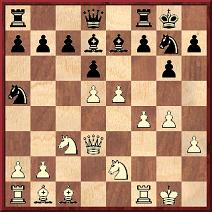
15…b6 16 b4 Nb7 17 Ne4 f5 18 exf6 Bxf6 19 N2c3 c5 20 dxc6 Bxc6 21 Qc4+ d5 22 Qxc6 dxe4 23 Bb2 Rc8 24 Qxb7 Bxc3 25 Bxc3 Rxc3 26 Bxe4 Rxh3 27 Qd5+ Kh8 28 Qxd8 Rxd8 29 Kg2 Rc3 30 Rad1 Rcc8 31 Rxd8+ Rxd8 32 f5 gxf5 33 gxf5 Kg8 34 Kf3 Rd6 35 Rc1 Rd7 36 Kf4 Kf8 37 Rc8+ Ke7 38 Ke5 Nh5 39 Bc6 Nf6 40 Bxd7 Nxd7+ 41 Kf4 Resigns.
... I shall be able to give next week a lively and highly interesting game which a Southwark Catholic drew recently with Capablanca. The game will be given with many notes, which should be of great help to novices and players of moderate strength.’
Noting that the second game did not appear, Mr Valois also provides The Tablet’s chess column of 20 August 1949 (by which time D.M. Davey had taken over from Eugene O’Sullivan, who died in 1948). It included the following:
‘Capablanca’s remarkable insight into position made him excel also at simultaneous displays. On one occasion in 1919 he defeated 39 out of 40, Fr O’Sullivan (my predecessor) being the only player to escape defeat:
José Raúl Capablanca – Eugene O’Sullivan
1919
King’s Gambit Declined1 e4 e5 2 f4 Bc5 3 Nf3 d6 4 c3 Nf6 5 d4 exd4 6 cxd4 Bb6 7 Nc3 Nc6 8 Bb5 Bd7 9 Be3 Qe7 10 Bd3 Nb4 11 Bb1 d5 12 e5 Ne4 13 Nxe4 dxe4 14 Bxe4 f5 15 Bb1 Nd5 16 Qd2 O-O-O 17 Bf2 Qf8 18 O-O h6 19 a4 a6 20 a5 Ba7 21 Ba2 Be6 22 b4 g5 23 fxg5 hxg5 24 Nxg5 Qh6 25 Nf3 f4 26 h4 Rdg8 27 Kh2 Rg4 28 Rac1 Bb8 29 Rc5 Qg6 30 Rg1
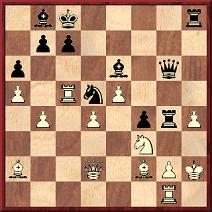
30...Rg3 31 Bxd5 Bxd5 32 Qxf4 Rg4 33 Qf6 Qxf6 34 exf6 c6+ 35 Ne5 Rf4 36 Bg3 Rxf6 37 Rxd5 cxd5 38 Rc1+ Kd8 39 Rc5 Ke7 40 Rxd5 Ke6 41 Rc5 Bd6 42 Rc1 Bxb4 43 Rd1 Kd5 44 Rb1 Bxa5 45 Rxb7 Bd2 46 Nf3 Bf4 Drawn.
And owing to the lateness of the hour Black accepted the proffered draw.’
The reports in The Tablet correspond to no known event, but if they were published on a delayed schedule, and with several factual errors, the likelihood is that both games were played in a display (+36 –0 =4) in Kingston (Surrey) on Wednesday, 29 October 1919. An account on pages 65-66 of the December 1919 Chess Amateur began:
‘Unusual interest was aroused amongst Kingston chessplayers when Señor Capablanca, the world’s champion [sic], paid a visit to Kingston under the auspices of the Thames Valley Chess Club ... Prior to the play Señor Capablanca was entertained to dinner by the committee, the Rev. Father O’Sullivan, vice-president, occupying the chair ...’
The list of defeated players included Rev. W. Morgan. Although Rev. E. O’Sullivan was not listed, a player who drew was Rev. E. ‘Malden’ (with the surname in quotation marks, as for a pseudonym). See also page 64 and pages 132-134 of the 2/1999 Quarterly for Chess History.
How quaint such comments seem in today’s more hectic era.
‘What is a chess master player? What is the difference between a “master” and a “grand master”? About what date may we anticipate the advent of the “great grand master”? These are the conundrums of the moment for the amusement of any detached spectator of the chess world.
Time was when there were no masters. There were plenty of woodshifters (as now), and a few good players of varying strengths (as now). But this must have been in a pre-historic era; even As-Suli has a boast about his mastership. Having invented the stupid term “master” (thrice stupid – untrue, unnecessary, unholy in its commercialism) the few good players temporarily basked in a complacent glow of superiority.
Unhappy men! Fools! Were they permitted to enjoy their superiority undisturbed? Not on your life! By this path, and that snicket, and yonder ginnel, crept woodshifter after woodshifter into the sacred circle. With no precise definitions, interpreted by Babel in as many ways as the tongues of Europe, a flood of mediocrity has swamped the realm of “masters” thoroughly and efficiently as commercialism must ever swamp mere merit.
The few good players of the age have realized that “master” is a ruined term. In self-defence someone has invented “grand master” as a new mark. Futile endeavour – at the present rate of production of “grand masters” it is a calculable distance to their successors, the “great grands”.
Is there not here, again, work for the FIDE?’
The above is an article by ‘Theta’ on page 129 of the Chess Amateur, February 1926.
From page 32 of CHESS, November 1948:
‘According to an announcement by Grob, Bogoljubow has invented a new game of “movement”, using chessmen and the chessboard. The whole game lasts at most 35 moves.’
Wanted: more details.
A simple question, followed by a difficult one:

Irving Chernev
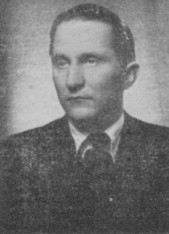
The gravest accusations ever made against a chess master concern the wartime record of Karlis Ozols of Latvia. An outline of the charges and an overview of his chess career are provided in our article War Crimes.
The game described by Chernev as ‘the greatest masterpiece ever created on a chessboard’ was, of course, Bogoljubow v Alekhine, Hastings, 1922. See page 281 of his book The Chess Companion (New York, 1968).
He gave his choice of ‘the three greatest games ever played’ in a letter on page 97 of Chess Review, April 1951: Bogoljubow v Alekhine, Hastings, 1922; Pillsbury v Tarrasch, Hastings, 1895; Réti v Alekhine, Baden Baden, 1925.
On the inside front cover of the November 1951 Chess Review Chernev also offered his nomination for ‘the dullest game ever played’: the 100-move Noa v Winawer, London, 1883.
This illustration appeared on page 497 of The Strand Magazine, May 1914, and we should welcome any information on the occasion:
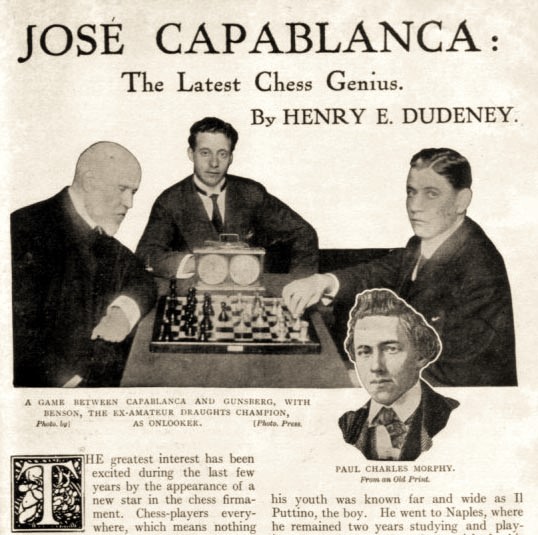
Page 499 of the same issue had another forgotten photograph of Capablanca, which we reproduce at the start of our Capablanca Goes Algebraic article. This is one of ten feature articles now available in the Archives, and additions will be made there from time to time.
From Rick Kennedy (Columbus, OH, USA):
‘The opening 1 e4 e5 2 Nf3 Nc6 3 Bc4 Nd4 has been called the Blackburne Shilling Gambit, in recognition, apparently, of J.H. Blackburne’s use of it to win small stakes from players. However, I have yet to find a single game with it played by Blackburne. In fact, the earliest game uncovered was played in New Zealand in 1911. How did Blackburne’s name become attached to the variation? Indeed, when did it become attached?
Steinitz’s Modern Chess Instructor has a note on the line, but does not refer to Blackburne. Mr Blackburne’s Games at Chess makes no mention of it. Nor does Freeborough and Ranken’s Chess Openings Ancient and Modern attribute the line (given in a footnote) to anyone. E.E. Cunnington’s books (one on traps, one on openings for beginners), which were published in London shortly after the turn of the century, give the moves but do not name Blackburne.
One clue may be that the first edition of Hooper and Whyld’s Oxford Companion to Chess (1984) does not call the line by name, but the second edition (1992) calls it the Blackburne Shilling Gambit. Did the co-authors discover some historical information during that eight-year period?’
On page 109 of the May 1956 Chess World M.E. Goldstein stated that Savielly Tartakower (‘a many-sided genius’) had been ‘a competent poet in Russian, German and French’. Wanted: further information.
A 1937 US magazine stated that X was ‘not so many years ago considered this country’s leading amateur chessplayer’.
Who was X? If any correct answers are received we shall be astounded.
Pages 254-255 of CHESS, August 1951 reproduced the score of the FIDE Anthem, with music by Count dal Verme (1908-1985) and words by Marcel Berman (1895-1960).
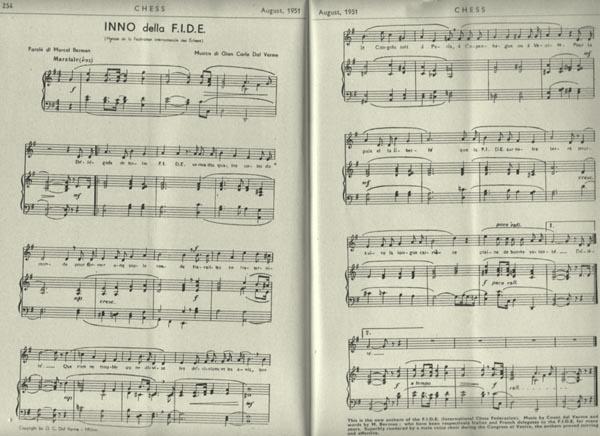
How often the composition has graced FIDE proceedings since 1951 we do not know. We refrain, moreover, from commenting on whether, today, the Federation requires not an Anthem but a Requiem.
Michael McDowell (Westcliff-on-sea, England) submits this three-mover by Isaac Kashdan:
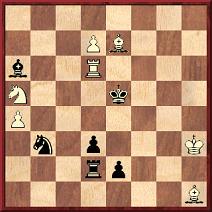
Mate in three.
At present no source is available; can any reader kindly provide it?

This is the front page of The Cricket, 5 January 1896. The caption at the bottom reads:
‘Problem for international chess-cranks. Players: Grover Cleveland and Lord Salisbury. Grover to Play and Mate in Three Moves.’
We seek information about S. Hindin, who won the 1937-38 New Zealand championship. A feature about him on page 41 of The Australasian Chess Review, 26 February 1938 stated that, although a native of Riga, Hindin ‘has spent most of his last 25 years in the British Empire and is British by naturalization. He has lived in New Zealand since 1930’. The paragraph that especially interests us is the following:
‘He was at school with Nimzowitsch, who was a great friend of the Hindin family. He played hundreds of games with Nimzowitsch and his father.’
What more is known about this connection?
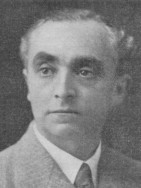
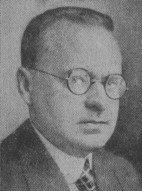
S. Hindin and Aron Nimzowitsch
Pages 26-27 of the 20 January 1938 Review gave Hindin’s last-round game in the New Zealand championship, which won him the first brilliancy prize:
S. Hindin – W. Lang
Dunedin, 1937 or 1938
English Opening
1 c4 e5 2 Nc3 Nf6 3 g3 d5 4 cxd5 Nxd5 5 Bg2 Nb6 6 d3 Be7 7 f4 exf4 8 Bxf4 c6 9 Nf3 N8d7 10 O-O Nf6 11 e4 O-O 12 Qe2 Bg4 13 h3 Bxf3 14 Qxf3 Bc5+ 15 Kh2 Bd4 16 a4 Nbd7 17 Rad1 Ne5 18 Qe2 h6 19 Bxe5 Bxe5 20 d4 Bc7 21 e5 Nd5 22 Ne4 Qe7
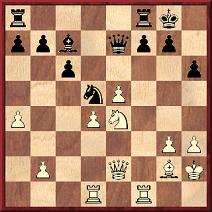
23 Nf6+ (‘Hindin agrees with us that the sacrifice was rather spectacular than necessary, and admits that he played it mostly out of consideration for the onlookers, who had waited 25 minutes for him to move.’) 23...Nxf6 24 Rxf6 gxf6 25 Qg4+ Kh8 26 Qh4 Bxe5 27 Re1 Qe6 28 Qxh6+ Kg8 29 dxe5 f5 30 Qf4 Rfd8 31 g4 fxg4 32 Be4 Kf8 33 Bf5 g3+ 34 Kxg3 Qb3+ 35 Re3 Qxb2 36 Be6 Resigns.
The above quote is taken from a follow-up item about Hindin on pages 69-70 of the 30 March 1938 Review. This added the information that he was born in Riga in 1888.
We are still hoping to find out more about a matter mentioned in C.N.s 385 and 2763 (see page 129 of A Chess Omnibus), i.e. why Francis Wellmuth’s 1943 book The Golden Treasury of Chess later removed his name and eventually credited authorship to Al Horowitz. See also C.N. 3722, which presented a photograph of Wellmuth.
To return to basics, below is a descriptive list of the various editions of the book in our collection:
1. A hardback published in the ‘chess classics series’ by David McKay Co., Philadelphia, 1943 (304 pages). The title page stated The Golden Treasury of Chess compiled by Francis J. Wellmuth, and the frontispiece was a full-page photograph of him. The imprint page had ‘Copyright, 1943 by Horowitz & Harkness, New York, N.Y.’. Page v was an introduction by Frank J. Marshall dated January 1943 which mentioned Wellmuth by name in the following paragraph:
‘The title at once brings to mind one of the most beloved books in the English language. As we all know, it was Palgrave’s object, when he assembled the beautiful poems which comprise The Golden Treasury, to gather into one convenient volume the choicest productions of our literature through several centuries. Mr Wellmuth has had in mind precisely the same goal with respect to chess, and the result has been a really magnificent compilation of fine games.’
The book contained, on page viii, a 1902 acrostic by Wellmuth as a tribute to ‘Harry Nelson Pillsbury’, to whom the book was dedicated. There were 540 games, including four played by Wellmuth.
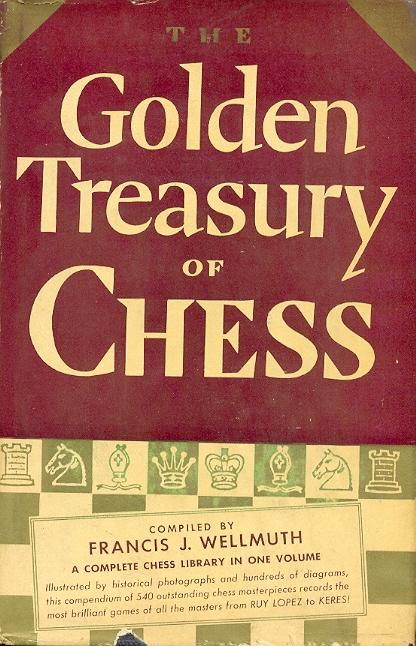
2. A ‘First Edition Limited to 500 copies’ signed by Wellmuth. The same contents as the above book, except that on the title page the publisher was not McKay, Philadelphia but ‘New York Horowitz & Harkness’.
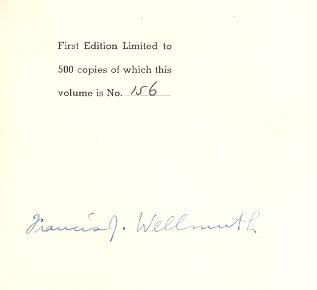
3. A hardback revised edition from Harvey House, New York (326 pages), the title page of which said ‘Compiled by The Editors of Chess Review’. The imprint page had ‘Copyright, 1943 By Horowitz & Harkness’ and ‘Copyright, 1956 By I.A. Horowitz’. Marshall’s Introduction (with its reference to Wellmuth) and Wellmuth’s own introductions (with the first person singular pronoun) were still there, as were Wellmuth’s four games, but the acrostic had gone, as had the frontispiece photograph of Wellmuth, who was mentioned nowhere as the author or compiler. A Part VII (‘The Period of Russian Hegemony’) was added (on pages 299-320), comprising 31 games played between 1943 and 1956.
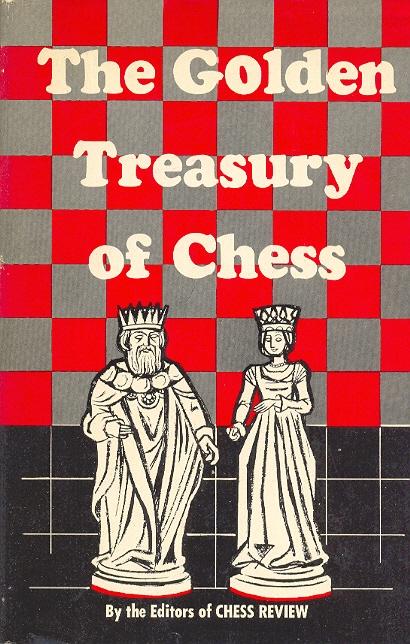
4. A hardback edition from Arco Publications Limited London, identical to the previous item, except that the imprint page stated ‘Copyright in England, 1958’ and all the photographs in the above editions were omitted.

5. A paperback edition published by Barnes & Noble in 1961 (328 pages), with authorship ascribed on the title page as: ‘Compiled by Al Horowitz and The Editors of Chess Review.’ The imprint page had ‘Copyright, 1943 by Horowitz & Harkness’ and ‘Copyright, 1956, 1961 By I.A. Horowitz’, as well as the following: ‘Published in 1961 by Barnes & Noble, Inc. by special arrangement with Z.E. Harvey, Inc.’ There was a second printing in 1962. A further four games were added, from the period 1956-60, making a total of 575.
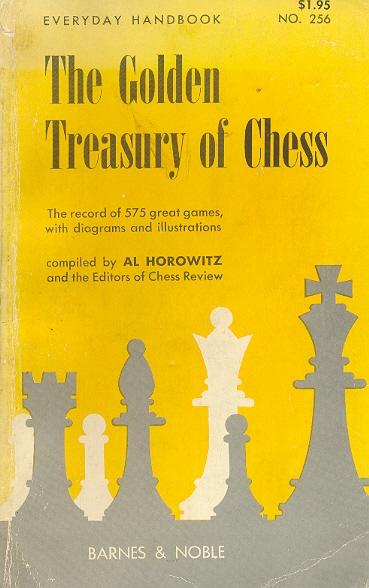
6. A hardback edition from Galahad Books, New York City (191 pages), again with ‘Compiled by Al Horowitz and The Editors of Chess Review’ on the title page. The imprint page stated: ‘Copyright 1969, 1961, 1956 by I.A. Horowitz. Copyright 1943 by Horowitz and Harkness.’ Marshall’s Introduction, with its reference to Wellmuth, had gone. Although 11 games were added from 1962 to 1966, many of the earlier games (including all four of Wellmuth’s) were removed, and there were only 322 in total.
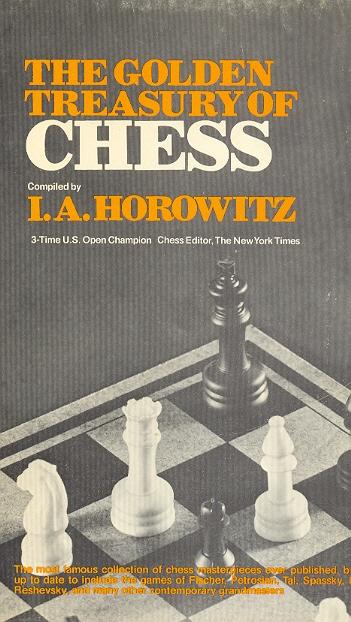
7. Various paperback reprints (from 1969 to 1978) by Cornerstone Library, New York, of the preceding edition, although the imprint page stated: ‘This completely new revised edition is published by arrangement with I.A. Horowitz and Harvey House, Inc.’ The later reprints of this paperback had an extra game (won by Tal in 1964) on the previously blank page 186.
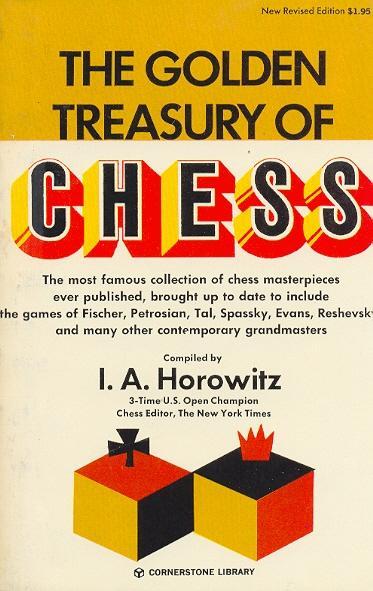
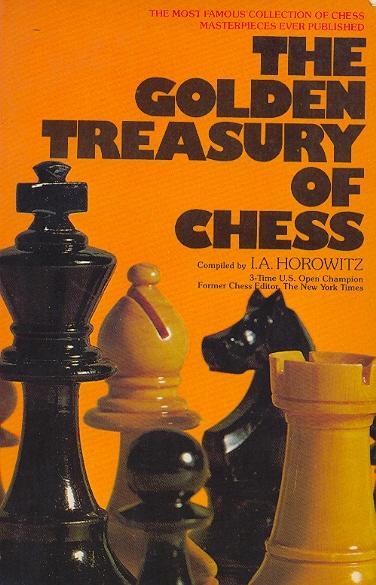
Wellmuth’s introduction to Part I in the original 1943 edition (page 1) included the following:
‘In the course of the decades which I have devoted to the preparation of this volume, I have had occasion to examine thousands upon thousands of scores. Those that have pleased me most are included in The Golden Treasury of Chess. But even among these favorites, there are some which I have enjoyed so much that I have set them aside in order to attract the reader’s attention to these games. I will not deny that ten years ago I might have selected other games, and that in the years to come, my tastes will again be modified. Nevertheless you will be delighted with these games.’
These personal words from Wellmuth were still there in the latest edition of the book that we have seen (1978), even though acknowledgement of his authorship of the book had long since been dropped. Indeed, we were about to write that Wellmuth’s name never appeared on any title page after the original 1943 editions, until we noted that according to page 274 of Douglas A. Betts’ Bibliography the 1943 book was ‘issued in Great Britain by Pitman, 1947’. Having never seen that UK version, or found it mentioned in various other bibliographical listings, we should like to hear from any reader who owns a copy.
C.N. 3480 presented a wordless book review, but the most celebrated brief critique is Tony Miles’ two-word dismissal of an Eric Schiller volume, on page 56 of the Autumn 1998 Kingpin. Now we note the following in the review section on page 78 of the July-September 2005 issue of Stefan Bücker’s magazine Kaissiber (each issue of which represents an extraordinary amount of work):
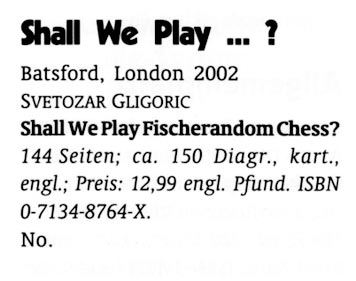
From page 93 of CHESS, February 1951:
‘The Russian master Verlinsky has died after a long illness. Remarkable was the fact that he learnt chess only at the late age of 30, yet scored a sensational victory over Capablanca in the tournament at Moscow in 1925. In 1929 he won the USSR championship.’
It is unclear where CHESS obtained this ‘fact’ about his age. Boris Verlinsky (born in 1888) won a tournament in Odessa in 1910, ahead of Bogoljubow.
A miscellany of three rare photographs of Alekhine. The first dates from around 1927, the second shows him in play against Flohr at Hastings, 1933-34, and the third was taken at Hastings, 1936-37.
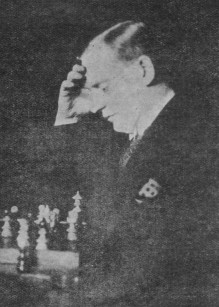

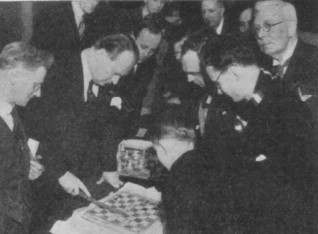
For those who would welcome a hint as to who was described by a 1937 US magazine as being ‘not so many years ago considered this country’s leading amateur chessplayer’ we give the initial of his surname: P. Even now he remains singularly difficult to identify, and we shall revert to this topic shortly.
Kaissiber unwittingly duplicated an idea already expressed in the BCM. Brad Dassat (Oldham, England) quotes to us page 533 of the October 2002 BCM, where the review of Shall We Play Fischerandom Chess? began:
‘The reviewer had to fight back the temptation to break Tony Miles’ world record for using the fewest words in a chess book review by saying “No” in answer to the title.’
From Taylor Kingston (Shelburne, VT, USA):
‘Reading the new Najdorf: Life and Games I noticed this improbable anecdote on page 251:
“It was during the same Margate congress [i.e. 1939] that Najdorf received a compliment from Samuel Tinsley: ‘Mr Najdorf, your play is most insouciant.’ Taking this unfamiliar word to mean something like careless instead of carefree, Najdorf retorted angrily: ‘Are you insulting me?’”
Samuel Tinsley, chess columnist for The Times, died in 1903. Gaige’s Chess Personalia lists also an Edward Samuel Tinsley (a son, perhaps?), but he died in 1937. Thus attendance by either at Margate, 1939 seems unlikely.
Was there yet another Samuel Tinsley, or is this just another “good story”?’
That Edward Tinsley (1869-1937) was the son of Samuel Tinsley (1847-1903) is a fact (see, for instance, page 503 of the October 1937 BCM and page 327 of A Chess Omnibus). The BCM item stated regarding Edward Tinsley:
‘After the death of his father in 1903 he and his two brothers took over the chess work for the Times, and their collaboration continued until 1912, when Edward took full charge.’
As noted on page 147 of A Chess Omnibus, in January 1926 a radio presentation about chess on the British Broadcasting Company was made by ‘Mr S. Tinsley’, a brother of Edward. His forename was Samuel (BCM, April 1903, page 159), but we do not know whether he was still alive in 1939, whether he was the person who spoke to Najdorf or, indeed, whether the alleged 1939 exchanges occurred at all.
We have now come across an earlier reference to A.E. Blackmar and Gone with the Wind, on page 3 of Discover The Blackmar-Diemer Gambit, volume 1 by Anders Tejler (Dallas, 1971), a book for which Ken Smith was billed as the editor:
‘Armand Edward Blackmar was born in Bennington, Vt. on 30 May 1826. By 1845 he was Professor of Music at Centennary [sic] College, Jackson, La. In 1856 he founded the first piano and music store in Jackson, Miss. By 1860 he and his brother opened a music publishing house in New Orleans, La. Here was published a famous song of the Confederacy: The Bonnie Blue Flag. Blackmar arranged the music for various songs, including the Dixie War Song and the Southern Marseillaise. When New Orleans was taken in 1862, Blackmar remained in the city; his brother, H.C. Blackmar, continued publishing patriotic music for the Confederacy in Augusta, Ga. At the end of the Civil War, the music house of Blackmar was confiscated and he was subjected to a heavy fine. One of Blackmar’s musical compositions was heard in the music to the film Gone with the Wind. Blackmar died in New Orleans on 28 October 1888. He was not only an eminent pianist but also a very good violinist. He was a chess expert, a charter member of the Chess, Checkers and Whist Club of New Orleans.’
Can these statements (similar, but not identical, to what was quoted in C.N. 3753) be corroborated?
Readers are invited to reflect upon where and when these two group photographs were taken:
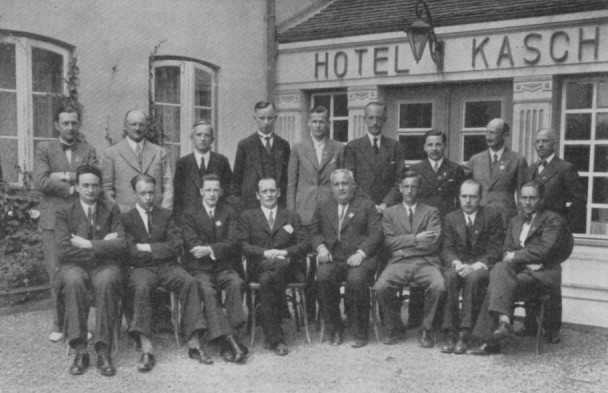
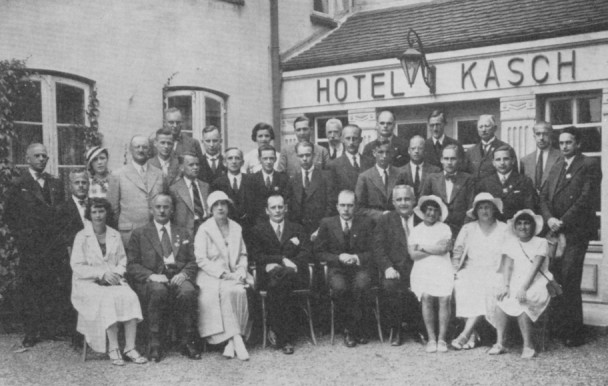
Peter Treffert (Lorsch, Germany) has sent us an article by Michele Visco about Verlinsky, entitled ‘First Russian Grandmaster of Chess’, in the August 1998 issue of Deaf History Journal (published by the British Deaf History Society). Although it provides no information on when Verlinsky learned chess, it reports that he was deaf from birth (but learned to speak in his teens) and that he was awarded the (Soviet) grandmaster title following his victory in the 1929 USSR Championship in Odessa. The article quotes from that year’s Shakhmatnyy listok the minutes of a decision by the ruling Soviet chess body to accord him the title for life, with the official presentation to be made by N. Krylenko.
Our correspondent furthermore quotes from pages 28-29 of The Soviet Championships by B. Cafferty and M. Taimanov (London, 1998) the following passage in the section on Odessa, 1929:
‘For his victory, Verlinsky was awarded the title of Soviet Grandmaster, though this was later taken away from him in 1931 when the GM title was abolished. By that time Verlinsky’s health and results had deteriorated and it was thought symbolic to make Botvinnik the first Soviet GM. The title was awarded to him in 1935. In 1929, though, Verlinsky was worthy of the honour, having victories to his credit over Capablanca, Rubinstein and Spielmann.’
Mr Teffert asks:
‘Did the authorities take away Verlinsky’s title because they considered that he was no longer a strong chessplayer?’
When was the term ‘grandmaster draw’ coined? On the first page of the Introduction to his book Prague 1946 (Sutton Coldfield, circa 1951) H. Golombek wrote: ‘the number of so-called “grandmaster draws” can be counted on the fingers of one hand.’ How much further back can the phrase be traced?
Below is an inscription by Golombek in our copy of Prague 1946 to the Czech master Jaroslav Šajtar:
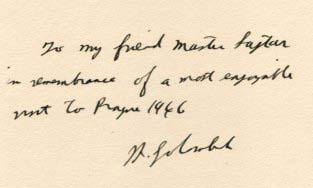
No information has yet been found about Joseph Goebbels’ alleged interest in chess. In 1960 ‘Assiac’ (i.e. Heinrich Fraenkel) co-authored a biography of him with Roger Manvell, but we have noted no references to chess in it.
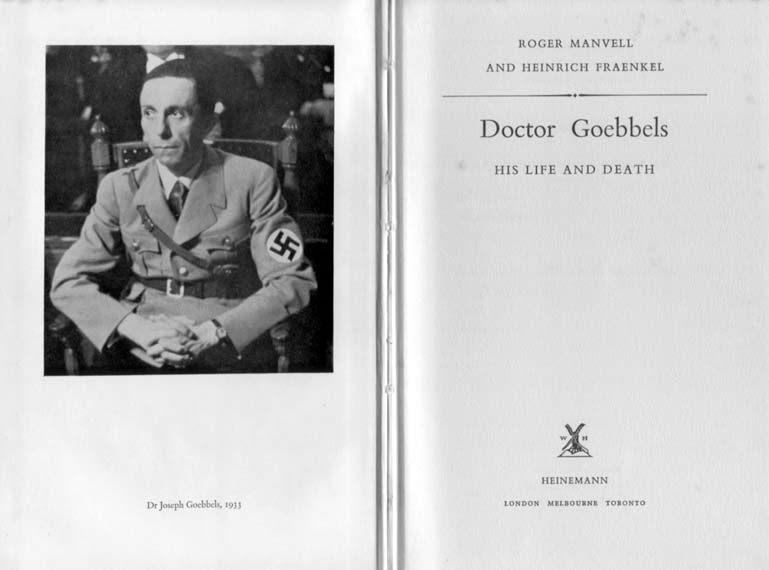
From page 64 of Games Digest, September 1937 (a magazine edited by Ely Culbertson):
‘Frank Perkins, another of our contributors on chess, directs his article to the attention of the average player. But Perkins is far above the average class. While he has retired from active competition, Frank was not so many years ago considered this country’s leading amateur chessplayer. His retirement, by the way, was not caused by old age, but by the fact that he now devotes most of his attention to contract bridge, at which he is an equally famous star. A native New Yorker, Frank is now settled in Boston.’
Frank Kendall Perkins (1891-1971) was a participant in New York, 1916 (the Rice Memorial tourney) but hardly a well-known chess figure, even during his lifetime. A biographical feature on him appeared on pages 12-13 of the January 1919 American Chess Bulletin, from which we reproduce the photograph below:
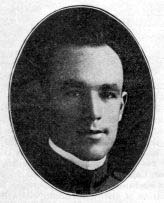
Frank Kendall Perkins
Perkins’ pre-eminence in the Brooklyn Chess Club was mentioned on page 223 of the November 1916 American Chess Bulletin, which reported that he had recently been ‘deposed’ by J.H. Taft, Jr. We are, incidentally, still seeking information about Taft, whom Marshall defeated in a match in New York in 1910 (+2 –1 =2). See pages 177-178 of Chess Explorations for Taft’s win.
C.N. 2221 raised the subject of the first chess master to act in a film. We suggested A.B. Hodges (1861-1944), on the basis of the following ‘Hodges in the Movies’ item on page 47 of the February 1918 American Chess Bulletin:
‘Albert B. Hodges, ex-United States chess champion, has made a number of appearances on the screen, notably as a member of the Russian Duma in War Brides, the Police Inspector in The Auction Block, the Coroner in Empty Pockets and the Butler in the new Brenon picture False Faces.’
Can any reader discover information about Hodges’ acting career?

Albert Beauregard Hodges
In an article on the inside front cover of Chess Review, October 1951 Irving Chernev made a statement on which we would welcome particulars:
‘Reshevsky made his debut on the radio by singing a love song.’
Any reader who has not visited our Archives recently will find that they now offer over 20 feature articles dealing with a wide range of figures from Napoleon Bonaparte to Josh Waitzkin.
Chess Notes Archives:
| First column | << previous | Archives [11] | next >> | Current column |
Copyright 2005 Edward Winter. All rights reserved.